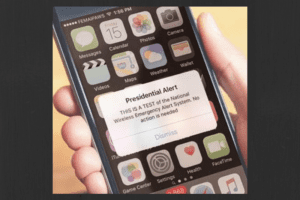Prueba nacional del sistema de alerta de emergencia reprogramada para el 3 de octubre
FEMA, en coordinación con la Federal Communications Commission (FCC), pospuso la prueba nacional del Emergency Alert System (EAS, Sistema de Alerta de Emergencia, por sus siglas en inglés) y el Wireless Emergency Alerts (WEA, Alertas de Emergencia Inalámbricas, por sus siglas en inglés) hasta el 3 de octubre, debido a los esfuerzos de respuesta en curso al Huracán Florence.
La parte de la prueba de WEA comienza a la 1:18 PM CDT y la parte de EAS sigue a la 1:20 p.m. CDT. La prueba evaluará la disponibilidad operativa de la infraestructura para la distribución de un mensaje nacional y determinará si se necesitan mejoras tecnológicas. Este es el primer mensaje nacional de prueba de WEA enviado a teléfonos celulares compatibles con WEA y el cuarto examen nacional de EAS enviado a través de medios de difusión.
La prueba WEA se enviará a través de IPAWS a la 1:18 p.m. CDT. Las torres de telefonía transmitirán la prueba WEA durante aproximadamente 30 minutos. Durante este tiempo, los teléfonos celulares que estén encendidos y dentro del alcance de una torre celular activa deben ser capaces de recibir el mensaje de prueba. FEMA enviará un mensaje de WEA a los dispositivos móviles y dado que el mensaje de WEA es una alerta presidencial, los usuarios no podrán optar por no recibir el mensaje, incluso si han desactivado las notificaciones de alerta en sus dispositivos móviles. El mensaje WEA se mostrará en dispositivos móviles como una alerta presidencial y dirá, “THIS IS A TEST of the National Wireless Emergency Alert System. No action is needed.”(“ESTA ES UNA PRUEBA del Sistema Nacional de Alerta de Emergencia Inalámbrica. No se necesita ninguna acción.”)
- El sistema WEA se usa para advertir al público sobre el clima peligroso, niños desaparecidos y otras situaciones críticas a través de alertas en teléfonos celulares.
- Los oficiales de seguridad pública estatales y locales, el National Weather Service (Servicio Meteorológico Nacional), el National Center for Missing and Exploited Children (Centro Nacional para Menores Desaparecidos y Explotados), y el presidente de los Estados Unidos pueden enviar los WEA.
- Los WEA se pueden emitir para tres categorías de alerta: amenaza inminente, AMBAR y presidencial.
- Los WEA parecen mensajes de texto, pero están diseñados para llamar su atención y alertarlo con un sonido y vibración únicos, ambos repetidos dos veces.
- Los WEA no tienen más de 90 caracteres, e incluirán el tipo y la hora de la alerta, cualquier acción que deba tomar, así como la agencia que emite la alerta.
- Los WEA no se ven afectados por la congestión de la red y no interrumpen los mensajes de texto, las llamadas o las sesiones de datos en curso.
- A los usuarios de dispositivos móviles no se les cobra por recibir WEA y no es necesario suscribirse.
La prueba EAS a la 1:20 p.m. CDT tiene una duración aproximada de un minuto y está disponible para los participantes de EAS, incluidos los presentadores de radio y televisión, los sistemas de cable, los proveedores de radio y televisión por satélite y los proveedores de video por cable.
Nationwide Test of the Emergency Alert System Rescheduled for October 3
 FEMA, in coordination with the Federal Communications Commission (FCC), has postponed the nationwide test of the Emergency Alert System (EAS) and Wireless Emergency Alerts (WEA) until October 3, due to ongoing response efforts to Hurricane Florence.
FEMA, in coordination with the Federal Communications Commission (FCC), has postponed the nationwide test of the Emergency Alert System (EAS) and Wireless Emergency Alerts (WEA) until October 3, due to ongoing response efforts to Hurricane Florence.
The WEA portion of the test commences at 1:18 PM CDT and the EAS portion follows at 1:20 p.m. CDT. The test will assess the operational readiness of the infrastructure for distribution of a national message and determine whether technological improvements are needed. This is the first national WEA test message sent to WEA-compatible cell phones and the fourth EAS nationwide test sent via broadcast media.
The WEA test will be sent through IPAWS at 1:18 p.m. CDT. Cell towers will broadcast the WEA test for approximately 30 minutes. During this time, cell phones that are switched on and within range of an active cell tower should be capable of receiving the test message. FEMA will send one WEA message to mobile devices and because the WEA message is a presidential alert, users will not be able to opt out of receiving the message, even if they have deactivated alert notifications in their mobile devices. The WEA message will display on mobile devices as a presidential alert and will read, “THIS IS A TEST of the National Wireless Emergency Alert System. No action is needed.”
- The WEA system is used to warn the public about dangerous weather, missing children, and other critical situations through alerts on cell phones.
- WEAs can be sent by state and local public safety officials, the National Weather Service, the National Center for Missing and Exploited Children, and the president of the United States.
- WEAs can be issued for three alert categories – imminent threat, AMBER, and presidential.
- WEAs look like text messages, but are designed to get your attention and alert you with a unique sound and vibration, both repeated twice.
- WEAs are no more than 90 characters, and will include the type and time of the alert, any action you should take, as well as the agency issuing the alert.
- WEAs are not affected by network congestion and will not disrupt texts, calls or data sessions that are in progress.
- Mobile users are not charged for receiving WEAs and there is no need to subscribe.
The EAS test at 1:20 p.m. CDT is scheduled to last approximately one minute and is made available to EAS participants including radio and television broadcasters, cable systems, satellite radio and television providers, and wireline video providers.

















